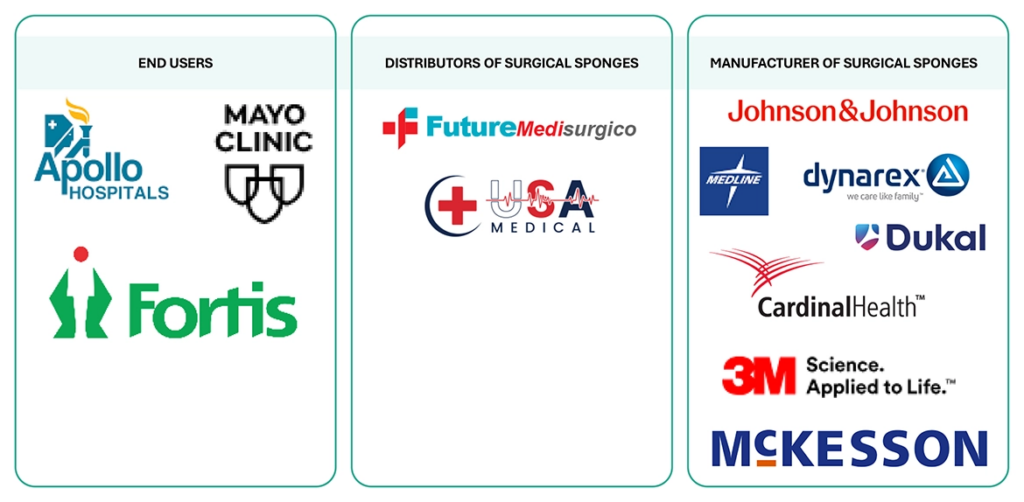The global surgical sponges market is experiencing significant growth, driven by advancements in healthcare infrastructure, an increasing number of surgical procedures, and technological innovations in surgical materials. As of 2024, the market was valued at approximately USD 0.81 billion and is projected to reach USD 1.19 billion by 2029, reflecting a compound annual growth rate (CAGR) of 7.9%.
Market Overview
Surgical sponges are essential medical devices used to absorb blood and other fluids during surgeries, ensuring a clear operative field. They are available in various types, including cotton gauze sponges, nonwoven sponges, laparotomy sponges, and x-ray detectable sponges. The demand for these products is closely linked to the volume of surgical procedures performed globally.

Key Market Drivers
- Advancements in Healthcare Infrastructure: The expansion of healthcare facilities, such as hospitals and ambulatory surgical centers, has led to an increased number of surgeries, subsequently driving the demand for surgical sponges.
- Technological Innovations: The development of x-ray detectable and radiopaque sponges has enhanced surgical safety by reducing the risk of retained surgical items. These innovations are becoming standard practice in operating rooms worldwide.
- Rise in Outpatient Surgeries: The growing preference for outpatient or ambulatory surgeries, which are more cost-effective and convenient, has increased the utilization of surgical sponges in these settings.
Market Segmentation
The surgical sponges market can be segmented based on product type, sterility, material, application, and end-user:
- By Product Type:
- Cotton Gauze Sponges: Made from 100% cotton, these sponges offer excellent absorption capabilities, making them ideal for absorbing blood and other fluids during surgery.
- Nonwoven Sponges: Manufactured from synthetic materials, these sponges provide high absorbency and are less linting compared to cotton gauze.
- Laparotomy Sponges: Designed for use in major surgical procedures, these sponges are larger and often equipped with radiopaque markers.
- X-Ray Detectable Sponges: Incorporate radiopaque elements to ensure visibility under imaging, reducing the risk of retained surgical items.
- By Sterility:
- Sterile Sponges: Individually packaged and sterilized, ready for immediate use in surgical settings.
- Non-Sterile Sponges: Typically used for non-surgical applications or sterilized on-site before use.
- By Material:
- Cotton: Natural fiber known for its softness and absorbency.
- Rayon: Semi-synthetic fiber offering a smooth texture and high absorbency.
- Polyvinyl Alcohol (PVA): Synthetic material known for its high absorbency and strength.
- By Application:
- Neurosurgery: Utilized to manage bleeding and protect delicate neural tissues.
- Laparotomy: Employed to absorb fluids and protect organs during abdominal surgeries.
- ENT Surgery: Used to control bleeding and maintain a clear surgical field in ear, nose, and throat procedures.
- General Surgery: Versatile use across various surgical procedures to manage bleeding and maintain hygiene.
- By End-User:
- Hospitals: Major consumers of surgical sponges due to the high volume of surgeries performed.
- Ambulatory Surgical Centers: Increasing adoption of surgical sponges driven by the rise in outpatient surgeries.
- Clinics: Utilize surgical sponges for minor surgical procedures and wound care.
Competitive Landscape
The surgical sponges market is highly competitive, with several key players contributing to market growth through product innovation and strategic initiatives. Notable companies include:
- Johnson & Johnson Services, Inc.: A leading player offering a wide range of surgical products, including high-quality surgical sponges.
- McKesson Corporation: Provides a comprehensive portfolio of medical-surgical supplies, emphasizing quality and safety.
- Cardinal Health: Offers a diverse range of surgical sponges designed to meet various surgical needs.
- Medtronic: Engages in the development of surgical products, including innovative sponge designs.
- B. Braun Melsungen AG: Provides a variety of surgical sponges focusing on safety and efficiency.
These companies are focusing on expanding their product portfolios, enhancing distribution networks, and engaging in mergers and acquisitions to strengthen their market positions.
Regional Insights
- North America: Holds a significant share of the surgical sponges market, attributed to advanced healthcare infrastructure and a high volume of surgical procedures.
- Europe: Demonstrates steady market growth driven by technological advancements and an increasing number of surgeries.
- Asia-Pacific: Expected to exhibit the highest CAGR due to improving healthcare facilities, rising medical tourism, and a growing geriatric population.
Challenges
Despite positive growth prospects, the surgical sponges market faces challenges such as the risk of retained surgical items (RSIs), which can lead to severe complications. Implementing comprehensive tracking systems to prevent RSIs involves additional costs and training, posing operational challenges for healthcare facilities.
